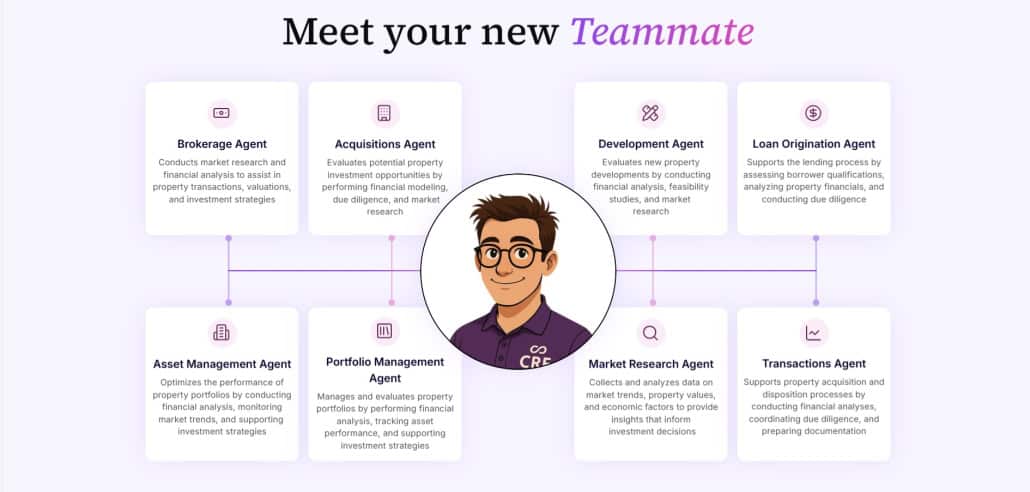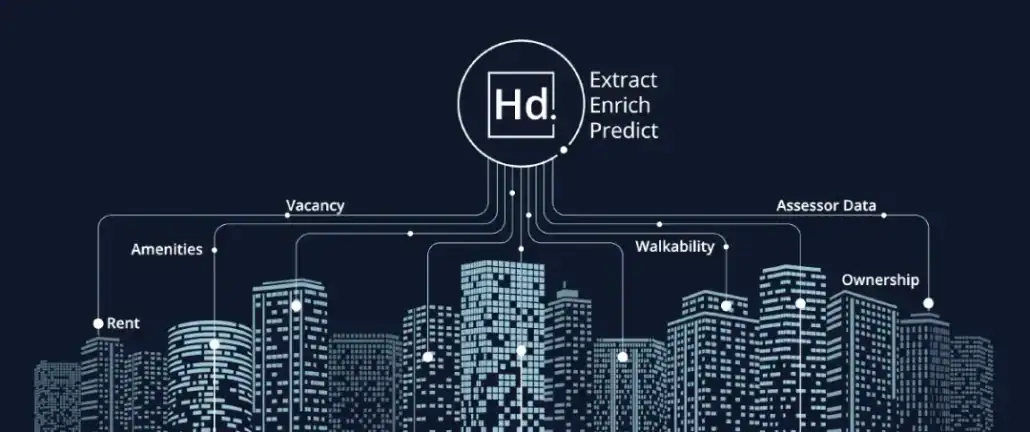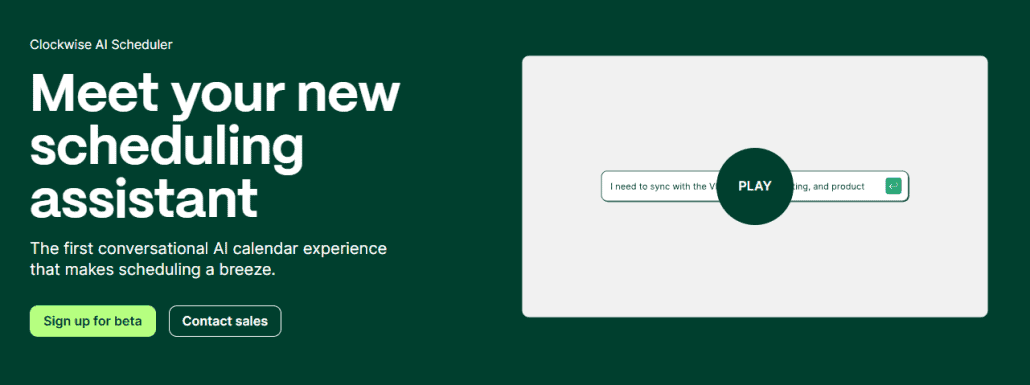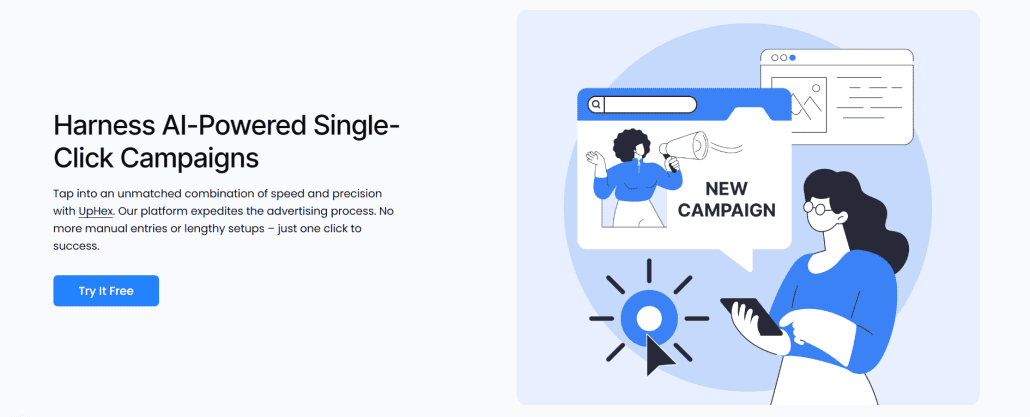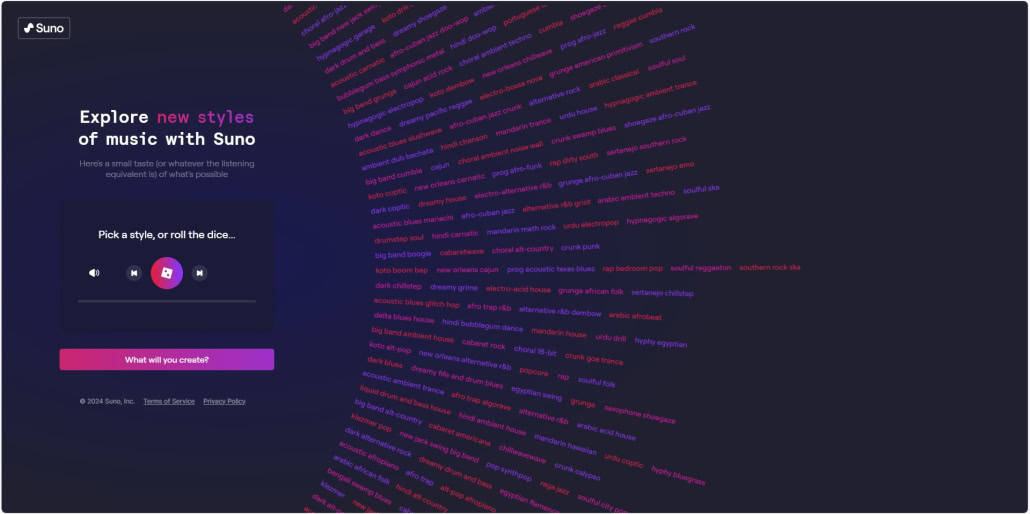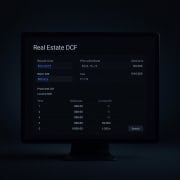AI Tools for Commercial Real Estate (Winter 2026 Edition)
If you haven’t noticed, we’ve been exploring use cases, training, and tools related to AI in commercial real estate a lot lately! The reason is that Artificial intelligence (AI) is poised to revolutionize the commercial real estate industry by transforming the way acquisitions, development, management, advisory, and marketing teams in the industry operate. AI tools are enabling CRE teams to process vast amounts of financial data, automate repetitive tasks, repackage existing content in more palatable formats, and gain valuable insights that can inform strategic decision-making.
In this blog post, we explore some of the AI tools that are most relevant to commercial real estate. This space is moving very fast. And so, as the industry adopts these tools, and as entrepreneurs create new tools, we will regularly release updated editions to this post.
Several years ago, we began adding updates to the key AI tools that we view as applicable to CRE. Those updates are included as bullet points to the tools below. We’ve also begun to add and remove tools based on their adoption, continued development, and/or emergence. We update this post on at least a quarterly basis, or as major updates came along.
Note from Spencer and Michael: We provide this post as a service, but do not endorse any of the tools listed here. While Spencer is a co-founder of a vertical AI agentic platform and A.CRE is the creator of an AI educational community for CRE, we seek to provide a fair airing of all AI applications that may benefit CRE professionals. If you have an AI tool you’d like added to this post, shoot us a note and we’ll consider whether it’s relevant.

One of the great unlocks of generative AI is that it empowers non-technical professionals—like those of us in commercial real estate—to build bespoke solutions for bespoke problems quickly and at minimal cost.
Regular AI Use Is the New Baseline
Artificial intelligence—whatever that actually means these days!—is rapidly becoming an integral part of how work gets done in commercial real estate. Whether you’re in acquisitions, development, management, investor relations, or brokerage, using AI regularly is now the expected baseline in a growing number of firms.
The true differentiator now lies in how reflexively you use these tools—integrating them seamlessly into your daily tasks to streamline workflows, automate tedious processes, and unlock new insights. By adopting an AI-first mindset, you free up time from the mundane and focus on what truly moves the needle: strategic thinking, better decision-making, and stronger relationships.
This guide introduces you to a growing list of AI tools applicable to real estate, each designed to help you work smarter, faster, and more efficiently.
Natural Language Models and Interfaces
OpenAI ChatGPT, ChatGPT Enterprise, and ChatGPT for Teams.
OpenAI’s ChatGPT continues evolving as the most widely adopted natural language interface, now supporting a vibrant ecosystem of third-party apps, enhanced agent capabilities, and deep integration with services like Canva and Zillow. In late 2025, OpenAI began rolling out GPT‑5.1 and GPT‑5.2 across ChatGPT and the API, pairing the Apps SDK with faster, more accurate models for professional and developer use (Link).
- GPT‑5.1 Models: GPT‑5.1 introduced warmer, more conversational behavior, better adherence to custom instructions, and improved tone controls, with personality and custom instruction updates now applying across both new and existing chats.
- GPT‑5.2 Instant, Thinking, and Pro: GPT‑5.2, OpenAI’s latest frontier release, is rolling out to paid ChatGPT tiers and the API, offering three variants optimized for speed, complex reasoning over long context, and maximum accuracy for demanding professional workloads.
- Expanded Integrations: Apps and integrations from partners such as Booking.com, Spotify, Figma, Coursera, and others now run directly inside ChatGPT, enabling in-chat commerce, workflows, and data exchange without leaving the conversation.
- Search, Safety, and Controls: Search has been upgraded for better factuality, shopping intent detection, and formatting, while OpenAI has expanded safety features, parental controls, and mental-health–oriented improvements to GPT‑5 Instant.
- Personalization and Policy: Personality and custom-instruction settings now apply instantly across all chats, and OpenAI has continued to refine data retention, privacy, and misuse-reporting tools for both consumer and enterprise users.
- Apps SDK & Apps Platform: Developers can create and publish interactive ChatGPT apps that run natively inside conversations, with discovery, testing, and invocation all happening in-chat via the new Apps SDK built on the Model Context Protocol.
- Agent Toolkits: New agent toolkits (often referred to as AgentKit/ChatKit in the ecosystem) help teams build autonomous, task-oriented agents with memory, multi-step workflows, and deep integrations into business systems.
Anthropic Claude AI, Claude Enterprise, and Claude for Teams.
Anthropic’s Claude, developed by former OpenAI researchers, remains a leading generative AI family for natural conversation, reasoning, and coding, now rapidly accelerating enterprise transformation and agentic AI workflow adoption (Link).
- Claude Sonnet 4.5 + Opus 4.5: Claude Sonnet 4.5 continues to set benchmarks in coding and agent performance, while the newly released Claude Opus 4.5 now serves as Anthropic’s most capable frontier model for complex enterprise tasks, advanced coding, and high-stakes decision support.
- Expanded Availability: Claude apps are now available on macOS, Windows, and major cloud platforms, with Sonnet 4.5 and Opus 4.5 deployed via services like Amazon Bedrock, Microsoft Foundry, and partner ecosystems, widening access for enterprise and developer teams.
- Enterprise Impact: Large organizations across software, media, and security—such as Databricks and others—now embed Claude Opus 4.5 and Sonnet 4.5 into products and internal tools, using them to power agents that handle end-to-end workflows in analytics, customer support, and engineering.
- Agent SDK & Agent Skills: Anthropic’s Agent SDK, combined with new Agent Skills and MCP code execution patterns, empowers enterprises to build fully autonomous AI agents with secure tool use, sandboxed execution, and modular skills that scale to production-grade workflows.
- Data Security, Transparency & Alignment: New introspection and transparency features allow Claude to surface reasoning summaries, uncertainty signals, and safer tool use, reducing factual errors and making the models more suitable for regulated and safety-critical environments.
- Privacy, Memory & Retention Controls: Anthropic extended memory and data controls for Team and Enterprise plans, including organizational memory, incognito chats, richer workspace settings, and clearer data retention policies for collaboration and governed rollout.
Google Gemini
Google’s Gemini (formerly Bard) is a next-generation conversational AI platform powering deep integrations with Chrome, Search, Workspace, Google Home, and Canvas, now anchored by the Gemini 3 model family for stronger reasoning, multimodal understanding, and agentic workflows across web, mobile, enterprise, and smart home devices (Link).
- Gemini 3 Launch: Google introduced Gemini 3 as its most capable model family to date, with Gemini 3 Pro delivering significantly improved reasoning, planning, and multimodal performance over Gemini 2.5, positioning it as a true “thought partner” for complex work.
- Deep Think & Advanced Reasoning: Gemini 3 adds Deep Think modes that expose and control the model’s “thinking level,” allowing users and developers to trade speed for deeper step-by-step reasoning, achieving state-of-the-art scores on benchmarks such as ARC-AGI-2 and GPQA Diamond.
- Gemini 3 for Enterprise & Vertex: Gemini 3 Pro is now available for enterprise through Gemini Enterprise and Vertex AI, powering agents and copilots used by partners like Box, Geotab, and Shopify for real production workloads in document analysis, fleet intelligence, and commerce.
- Antigravity & Agentic Coding: Google launched Antigravity, a developer environment where Gemini 3-powered agents can autonomously write, test, and iterate on code across editor, terminal, and browser panes, with Gemini 3 Pro also exposed via Gemini CLI and related developer tools.
- Computer Use & Multimodal Upgrades: Gemini 3 extends prior “computer use” capabilities with better screen understanding, form-filling, and app control, while improving multimodal analysis across text, images, video, and long-context documents for research and workflow automation.
- Gemini for Home & Assistant Replacement: Gemini continues replacing Google Assistant on Nest and compatible smart speakers and displays, with an accelerated Early Access program that onboards most users within 24 hours and broader rollout planned through 2026.
- Gemini Apps & Search Integration: Gemini 3 is being woven into Gemini apps and Google Search, enhancing AI overviews, complex query handling, and in-app agents, with ongoing release updates that refine formatting, visual understanding, and multi-language support.
xAI Grok
Elon Musk’s xAI advances Grok as a real-time AI assistant integrated with X, now centered on the Grok 4 and 4.1 model family with multi-agent reasoning, real-world data access, and multimodal generation for text, images, audio, and video (Link).
- Grok 4.1 & 4.1 Fast: Grok 4.1, rolled out after a silent A/B test in November, improves reasoning, multimodal understanding, personality, and hallucination rates versus Grok 4, while Grok 4.1 Fast adds a 2M-token context window and is tuned for rapid tool-calling and agentic workflows.
- Text-to-Video Generation: Grok’s “Imagine” feature converts text prompts into short AI-generated video clips with clearer motion, more natural lighting, multi-scene control, higher resolution previews, and tighter audio synchronization, making 6–10 second videos increasingly viable for social, ad, and explainer content.
- Live Real-World Data: Grok continues to ingest and reason over real-time streams from X, the wider web, news, and public filings, powering Deep Search–style results that surface fresh, source-linked insights rather than relying solely on a static training cutoff.
- Premium Tiers and SuperGrok: Grok offers a free base assistant plus premium options like SuperGrok and SuperGrok Heavy, which unlock higher-performing models (including Grok 4.x), expanded context, full Imagine access, and priority compute for power users, studios, and early adopters.
- Open Models & Licensing: Earlier Grok generations (such as Grok 2 families) remain available as open or community-licensed models for self-hosting and experimentation, giving developers lighter-weight options alongside the proprietary Grok 4.1 line.
- Safety, Personality & Memory: Grok 4.1 emphasises more natural, emotive dialogue with strengthened safeguards and lower hallucination rates, while evolving persistent memory to keep user context across longer sessions without sacrificing its “maximally truth-seeking” positioning.
- Developer API & Agent Tools: The xAI API now exposes Grok 4.1 Fast and an Agent Tools API for building agents that call external tools (search, web, code execution and more), enabling integration into dashboards, analytics pipelines, and custom applications with long-context, tool-using behavior.
DeepSeek
DeepSeek, originally incubated within quantitative hedge fund High-Flyer, has emerged as a leading developer of open-source large language models, focusing on efficient, low-cost alternatives to U.S. tech giants that are widely used by developers seeking transparency and performance (Link).
- DeepSeek‑V3.2 & V3.2‑Speciale: In early December, DeepSeek formally released V3.2 as the successor to V3.2‑Exp, along with V3.2‑Speciale, an extended‑thinking variant that achieves gold‑medal performance on IMO/ICPC/IOI‑style benchmarks and AIME 2025 scores around 96%, rivaling GPT‑5 and Gemini 3.
- Reasoning & Efficiency Gains: V3.2 adds DeepSeek Sparse Attention (DSA) and a “lightning indexer” to improve long‑context efficiency while maintaining or improving quality, offering GPT‑5‑level reasoning at substantially lower compute cost.
- Thinking Mode & Tool Use: DeepSeek’s API now supports “Thinking in Tool‑Use,” allowing V3.2 models to run explicit chain‑of‑thought internally when calling tools, which boosts performance on complex, multi‑step tasks without exposing raw reasoning traces.
- API Pricing & Cost Advantage: DeepSeek maintained its aggressive pricing, keeping V3.2 at roughly $0.028 per 1M cached input tokens and deeply discounted cache‑miss and output pricing, translating into more than 50%–75% savings versus earlier DeepSeek generations and many U.S. competitors.
- Open Source & Weights: V3.2‑Exp and related models remain available as open‑weight releases on platforms like Hugging Face and GitHub, with technical reports, kernels, and implementation details published for the research and self‑hosting community.
- Domain‑Specific Training: DeepSeek continues to expand domain‑specific training for math, coding, and scientific reasoning—building on DeepSeekMath‑V2 and earlier R1 updates—to push accuracy on technical benchmarks and support more reliable agentic workflows.
Meta Llama
Meta’s foray into the large language model space with their “open source” LLM. Llama is either accessed through frontend interfaces such as Meta.ai or by installing on your machine locally. (Link)
- Llama 4 Released (Apr 5, 2025): Meta unveiled Llama 4, introducing three models—Scout, Maverick, and the forthcoming Behemoth. These models are natively multimodal, capable of processing text, images, audio, and video. Scout supports a 10 million token context window, while Maverick offers 400 billion parameters with a 1 million token context window. The user base passed 650 million downloads; new hosting partnerships and expanded moderation tools (Llama Guard, Prompt Guard, Firewall, Code Shield) strengthen security and regulatory compliance. Approved for U.S. government use and new language support for global apps.
Educational Solutions – AI in Real Estate
As AI transforms commercial real estate, learning to use AI is emerging as an absolute necessity. A growing set of programs and memberships now teach CRE professionals how to integrate AI into their workflows, from research and underwriting to operations and marketing. Below are leading solutions available in 2025.
- AI.Edge (Course + Community – Ongoing): AI course for real estate, practical AI learning community created by industry veterans who currently apply AI at scale.
- Newly launched in August 2025, AI.Edge now features monthly Skill Drops (timely lessons each month), AI Multipliers (exclusive tools, prompts, and members-only apps like the AI Advisory Board), the Intelligence Brief (monthly curated insights), and The Build Showcase (community build competitions and sharing).
- The AI-Native Foundation course is now on-demand, regularly updated, and builds baseline fluency fast.
- Recent additions include a full “AI Agents for CRE” lesson/quiz and a 9-week AI-Native Playbook (Link).
- AI for CRE Collective (Community – Skool): A collaborative learning community focused on actionable AI in CRE. Members gain access to prompt libraries, workflow automations, weekly AI × CRE intel, proprietary systems, and optional AI build services, all designed to accelerate adoption. (Link)
- UCLA Extension – Artificial Intelligence in Real Estate (Live Online, Sept 22, 2025): The latest course covers the growing role of AI in valuation, analytics, investment optimization, location selection, and migration patterns. It explores ethical implications through case studies and practical examples. New for Fall: the class now sets prerequisites (market/financial analysis experience), features corporate education tracks, and supports community outreach/donations. (Link)
- Implementing AI in CRE (Starting Sept 11, 2025): A hybrid format with 6 modules, 120+ lessons, 4+ hours of video, plus weekly live Q&A. Topics include prompting, regression and neural nets, market analysis, DCFs, site selection, RAG workflows, CRM automations, and marketing. Certificate of completion included. Praised for its step-by-step practicality. (Link)
- Columbia Plus – Artificial Intelligence in Real Estate (Live Online, Sept 22 – Nov 12, 2025): Delivered by Columbia Engineering with 8 modules (~6–8 hours/week), guest lectures, hands-on coding, and a group project. Led by Josh Panknin, it emphasizes AI/ML strategy in real estate. Tuition: $2,000 with early-bird discounts. (Link)
AI Agentic Platforms (Horizontal and Vertical)
AI Agentic Platforms are environments that enable the deployment, coordination, and management of autonomous AI agents. These agents perceive their environment, make decisions, and execute actions iteratively toward achieving defined objectives. Unlike traditional SaaS tools, agentic platforms go beyond single-task automation — they integrate data sources, software tools, and dynamic workflows to perform complex, multi-step tasks autonomously. Agentic platforms typically allow users to create, modify, and orchestrate multiple AI agents with varying roles and toolsets.
Horizontal
- Beam AI (Horizontal): Beam.AI unveiled new integrations in October 2025, connecting directly to Microsoft Business, SharePoint, Apaleo, Google Sheets, TapClicks, and HubSpot for richer data-driven task automation. Platform updates added unified tool creation/testing, improved image/text parsing, progress tracking for agent setup, and smarter parameter extraction. ML-powered upgrades boost performance, faster PDF uploads, longer task memory, and AI-powered clarifications. Workspace management is now more streamlined, and bug fixes have strengthened reliability and efficiency. (Link)
- Lindy (Horizontal): Lindy’s September release added support for Gemini 2.5 Pro and new GPT-4.1 models (Nano, Mini, and 4.1). Context management actions improve state retention for agents, plus Google Docs/PDF actions make document workflows simpler. New agent monitoring, partner portal, and expanded web scrapers are now live. Beta “Code Action” lets users run Python/JS directly within workflows for custom automation. Multi-account support and WhatsApp integration make Lindy more versatile across inboxes and teams. (Link)
- AgentForce (Horizontal): Salesforce launched Agentforce IT Service with over 100 pre-built connectors and integrations (October 2025), unifying IT and HR workflows for auto-resolution and improved productivity. Winter ’26 updates for Agentforce Sales introduce enhanced security/privacy centers, new web-based lead generation agents, improved platform stability, and Customer360 productivity upgrades. Revised certification now emphasizes advanced agentic workflows and security. (Link)
- Google Vertex AI (Horizontal): Google Vertex AI is a horizontal AI platform that helps businesses build, deploy, and scale machine learning models across industries. (Link)
- Microsoft Copilot Agents (Horizontal): Microsoft Copilot Agents are horizontal AI assistants integrated into Microsoft 365, automating tasks across business functions to boost productivity. (Link)
- Gumloop (Horizontal): A no-code AI workflow automation platform that connects data across multiple sources, including OpenAI, Anthropic, Perplexity, Google, and enterprise apps like Slack, Notion, and Salesforce. Enables AI-driven automation for web scraping, SEO, document processing, and business analytics. (Link)
- n8n (Horizontal): An AI-native workflow automation platform designed for technical teams. Supports multi-step AI agents, real-time data integration, and custom automation using JavaScript, Python, and 400+ integrations. (Link)
- Manus (Horizontal): Built by Chinese startup Monica (Butterfly Effect AI), Manus is a multi-agent AI platform that autonomously executes complex tasks like resume screening, stock analysis, and site creation. It uses a modular sub-agent architecture and gained global attention in March 2025 with strong GAIA benchmark performance. (Link)
- Relevance AI (Horizontal): Relevance AI is a no-code platform that empowers teams and subject-matter experts to build and manage scalable teams of AI agents. (Link)
- Pipedream (Horizontal): Pipedream has evolved into an agentic automation platform with its AI Agent Builder (“String”), enabling agents to be built and deployed from natural language. (Link)
Vertical (CRE-Relevant)
- Symphony (Vertical – HR): SymphonyAI has expanded its IRIS Foundry platform with direct Microsoft Teams and Copilot integration, enabling frontline teams to launch AI-driven maintenance, quality, and energy workflows inside corporate collaboration tools. SymphonyAI was named a Leader in the Green Quadrant: Industrial AI Analytics Software (2025) by Verdantix, citing significant impact on efficiency, cycle times, and downtime. Enterprise adoption has accelerated across manufacturing and energy verticals, with measurable results like a 7% OEE gain and 15% reduction in unplanned downtime. (Link)
- Karmen (Vertical – Construction): Karmen remains a leading AI assistant for construction project managers, automating invoice approvals, RFI and change order tracking via integration with emails and project management platforms like Procore. The platform reportedly saves managers three hours per day and has improved adoption across general contractors and owners for admin process automation. (Link)
- Fresco (Vertical – Construction): Fresco’s AI copilot is now widely adopted by construction superintendents, leveraging video and voice transcription to automate daily logs, punch lists, and documentation in real time during site walks. Users report a 90% reduction in information retrieval time and major productivity gains for project managers and supers, with seamless integration into Procore and ACC for actionable jobsite insights. (Link)
- CRE Agents (Vertical – Real Estate): CRE Agents seeks to be the AI operating layer for commercial real estate—automating repetitive work across 17+ functional areas (acquisitions, asset management, brokerage, development, etc.) by streamlining processes and supporting broker engagement and asset management. Recently launched limited Pilot Program for select waitlist members (Link).
AI Coding Platforms and Tools
These platforms empower non-technical users—such as commercial real estate professionals and other subject-matter experts—to build applications without writing code. Sometimes called vibe coding platforms, they simplify development, automate workflows, and allow teams to rapidly prototype tools.
- Lovable.dev: Lovable Cloud launched (October 2025), enabling full-stack app building with zero manual database or authentication setup. Lovable AI now lets users build custom AI-native apps—like chat assistants, avatar/image generators, and coaching tools—entirely through chat and voice.
- Embedded Gemini-powered AI is free for all new apps through October 13; new “turn files into apps” feature lets you instantly convert resumes, spreadsheets, and presentations into interactive software.
- Security features and admin controls have been expanded, and a recent 7-day challenge resulted in thousands of new projects and showcased builds. (Link)
- v0.dev: Vercel’s v0 now supports direct image element editing in design mode (October 2025), allowing prompt-based regeneration and dynamic modifications—removing the need for Photoshop or third-party tools.
- The platform’s AI agent now offers experience for a wide range of roles (not just developers), and context-driven design adjustments are available.
- Recent iOS app beta, team templates, and quick palette/font/shadow changes make prototyping more powerful.
- Current models include v0-1.5-sm/md/lg, plus OpenAI GPT-5. (Link)
- Bolt.new: StackBlitz’s browser-based full-stack development tool, requiring no local setup. Recent expansions added hosting, authentication, databases, SEO, payments, and analytics—transforming it into an end-to-end development and deployment platform.Link
- RooCode (VS Code Extension): An AI-native VS Code assistant with multi-model support and plugin ecosystem. Recent updates brought clickable filenames, long-context support with GLM-4.5-Air (151k tokens), Grok Code Fast integration, Qwen CLI API access, and stronger security. Link
- Cursor: A modern AI coding editor that enhances productivity with project-aware suggestions. Version 1.2 added more resilient background agents, Slack and PR integrations, and better conflict handling. New enterprise controls support AI-code tracking, admin blocklists, and exports. Link
- OpenAI Codex: Now generally available, Codex uses GPT-5-Codex for agentic workflows, supporting adaptive thinking, multi-hour refactoring, comprehensive code reviews, and deep IDE integrations (VS Code, Cursor, GitHub PR automation, Rust CLI). (Link)
- Claude Code: Anthropic’s developer-focused AI tool that understands codebases and executes tasks via natural language. Now available in Enterprise and Team plans, it includes compliance APIs, governance features, cost-tracking, and revised privacy policies extending retention to 5 years (with opt-outs). Link
- Gemini Canvas: Google’s prototyping environment for apps, content, and internal tools powered by Gemini 2.5 Pro. New multimodal features allow prompting via camera and microphone, alongside upgrades to Deep Research, Veo 3 video generation, and Imagen 4 integration. Link
- Glide Apps: No-code platform that enables operations teams to transform spreadsheets or database sources into fully functional, professionally styled web and mobile apps via drag-and-drop UI, integrated data management, workflow automation, and AI-assisted app building—all without writing a line of code. (Link)
- Bubble: Bubble.io is a no-code platform that empowers non-technical users—from solo founders to enterprise teams—to visually design, develop, and deploy full-stack web applications. Its drag-and-drop interface, powerful workflow engine, built-in database, and API integration tools make it possible to build scalable, database-driven apps—like marketplaces, dashboards, or SaaS platforms—without writing any code. (Link)
Purpose-Built AI Tools/Apps for CRE
While agentic platforms support the creation and execution of autonomous agents, these software tools represent targeted AI-powered applications built specifically for commercial real estate. They typically focus on single-use cases like lease abstraction, underwriting automation, presentation creation, or communication management.
- LeaseLens: AI lease abstraction platform offering exports at $25 per commercial lease. (Link)
- Pipe.CRE: Unlocking the value of unstructured lease, sale, and expense comp data sitting on every users drive. (Link)
- Prophia: Asset and portfolio management platform with AI lease abstraction, now featuring instant abstraction for fast insights. (Link)
- Henry AI: AI-driven presentation platform that generates polished, deal-ready CRE decks from comps and underwriting data. (Link)
- Proda AI: Rent roll processing and roll-up platform with flexible API column configuration. (Link)
- Archer: Multifamily underwriting and investment platform with AI parsing, analysis, and a new comps benchmarking dashboard. (Link)
- DocSumo: AI document processing for underwriting, extracting and digitizing financial and lease data. (Link)
- Elise AI: AI property management platform automating leasing, resident communications, service requests, and payments. (Link)
Custom GPTs for CRE
Since custom GPTs were released by OpenAI in late 2023, we’ve been experimenting with and creating custom GPTs for commercial real estate. Below are several domain-specific GPTs we’ve built (now available to both paid and free users of ChatGPT).
- Advanced Mortgage Amortization Schedule: A tool that simplifies the process of building a mortgage amortization table by taking a series of inputs and automatically filling them into our Advanced Mortgage Amortization Schedule Excel model.
- Basic Real Estate DCF Model: A GPT that creates a basic DCF for the user, ultimately returning an Excel file to download with the results of the DCF including inputs, calculations, and return outputs.
- Code Helper for Financial Models: A GPT to help quickly audit, assess, and improve VBA code in Excel Financial Models such as those found on A.CRE. This custom GPT helped build our Excel 4 CRE custom add-in.
- Cover Letter Composer by A.CRE: A well-trained custom GPT that helps you draft a professional cover letter using a proven cover letter framework used by top universities and career coaches.
- CRE Technical Interview Coach: Friendly guide for real estate interview prep, focusing on case studies and modeling. This GPT helps users learn knowledge they need to tackle real estate technical interviews.
- Real Estate Case Studies Creator: A creative writer for real estate case studies. This GPT is tailor-built for young professionals looking to practice real estate financial modeling, professors looking to create cases for their lectures, and hiring managers wanting to build proficiency testing tools.
- STNL Sales Comp Analysis Tool: A GPT that helps users analyze single-tenant net lease (STNL) sales comps by generating key metrics and insights from input data, streamlining the process for evaluating comparable property sales.
- STNL Valuation Model Custom GPT: This GPT helps users perform valuations for Single-Tenant Net Lease (STNL) properties by guiding them through key inputs, including rent, cap rates, and tenant credit, to generate a comprehensive valuation model for investment analysis.
Tools for Excel and Google Sheets
- Excel 4 CRE Add-in. A free custom Excel add-in designed for commercial real estate professionals built by the team at A.CRE. Now includes AI-powered formula explanations, writing assistance, and Excel help, making it easier to understand, create, and debug financial models efficiently. (Link)
- FormulaBot. Now a full-featured AI-powered data analysis and transformation platform. Users can connect, analyze, visualize, clean, transform, and enrich data across multiple sources, including Excel, Google Sheets, Google Analytics, and more. Features include AI-generated insights, automatic chart creation, SQL query generation, spreadsheet automation, and text-to-formula conversion. (Link)
- SheetGod. Create intricate Excel formulas, macros, and automate manual tasks, using plain English and Google Appscript code snippets with the help of AI technology. (Link)
- MS Copilot in Excel. Unlock insights, identify trends or create professional-looking data visualizations in a fraction of the time. (Link)
- Formula Dog. This tool automatically converts text to Excel formulas, VBA code, and Regex, providing explanations along the way. Also compatible with Google Sheets, Airtable, and Notion. (Link)
- GPTExcel. A tool that generates complex Excel formulas from plain text. (Link)
- Endex: Currently an Excel-addin, this Excel-native AI agent seeks to offer in-sheet modeling, sourcing, and audited outputs. (Link)
- Shortcut AI: Web-based and available directly live in Excel via a plugin, AI agent that helps automate spreadsheet tasks, including data cleaning, model building, and chart creation. (Link)
Tools for Writing, Document Creation, and Editing
- LLMs. Use language prediction models to draft new and/or edit existing text.
- See ‘Natural Language Models and Interfaces’ section above for latest updates.
- MS CoPilot in Word. Write, edit, summarize and create in Word. (Link)
- CheckboxAI. Streamline document drafting, approvals, and e-signature process. The tool uses OpenAI’s GPT to help teams manage tasks and questions faster and easier. (Link)
- Type. AI-first document creation and editing tool. (Link)
- WordviceAI. Improve English writing with automatic error detection and correction capabilities. (Link)
- DocuWriter.ai. This tool auto-generates documentation from source code for all programming languages. (Link)
- BeautifulAI. Effortlessly create stunning presentations in minutes with AI-assisted design and smart slides. (Link)
- Handl. Handl is an AI document platform that transforms documents into data for multiple industries. (Link)
- QuillBot. AI writing assistant for faster and improved content creation. Includes tools for paraphrasing, summarizing, grammar checking, and generating SEO-optimized text across various writing tasks. (Link)
Tools for Organizing, Structuring, and Analyzing Real Estate Data
- OpenAI Advanced Data Analysis (formerly Code Interpreter). ChatGPT functionality that enables users to upload various files and execute operations like data analysis, image transformation, and code modification via ChatGPT. Now a built-in feature of ChatGPT, the feature can manage file uploads and downloads in diverse formats such as CSV/Excel.
- Trellis. AI-powered data platform that converts unstructured data from financial documents, voice calls, and emails into structured SQL format, enabling data teams to run queries and extract insights efficiently across 200+ data sources.
- LlamaIndex. Data framework for building LLM applications, enabling enterprises to connect, index, and query data from 160+ sources, and integrate with 40+ vector stores and document stores for diverse use cases.
Real Estate Data – Sourcing, Structuring, Analyzing
This section highlights key tools that help commercial real estate professionals source, structure, and analyze data from diverse formats and platforms to generate actionable insights.
- OpenAI Advanced Data Analysis (formerly Code Interpreter): Built-in ChatGPT feature that handles file uploads in diverse formats (CSV, Excel, etc.) for advanced analysis, transformations, and code execution.
- (See use cases and instructions for using Advanced Data Analysis)
- Trellis: AI data platform that converts unstructured inputs (financial docs, calls, emails) into structured SQL, enabling queries and insights across 200+ data sources.
- (Link)
- LlamaIndex: Framework for building LLM applications that connect, index, and query data from 160+ sources, with integrations across 40+ vector and document stores.
- (Link)
- HelloData AI: AI analytics platform for multifamily CRE, providing automated rent comps, pricing and concession data, property condition scoring, and benchmarking from millions of units. (Link)
Tools for Improved Communication
- Flowrite. Have your daily emails and messages written for you across your browser with an AI email writer tool. (Link)
- Clockwise. A conversational AI calendar assistant that simplifies scheduling by finding optimal meeting times, rearranging events, and managing calendar changes based on user preferences. (Link)
- MS CoPilot in Outlook. Synthesize and manage the inbox in Outlook. (Link)
- Relationship Coach AI. AI help and recommendations when responding to communications. (Link)
- Poised 2.0. An AI communication coach for confident and clear speaking. (Link)
- Yoodli. Yoodli is an AI-powered speech coach that provides free personalized communication feedback. (Link)
- Usetwain. Twain is an AI assistant that helps sales/marketing teams with effective outreach. (Link)
Tools for Social Media
- Lately. Convert long-form content into dozens of social media posts. (Link)
- Heyday. AI bot that engages with social media audience in comments. (Link)
- Omneky. Generates personalized social media ads using AI. (Link)
- UpHex. Automate Facebook (and other online) advertising campaigns. (Link)
- AI Social Bio. AI Social Bio generates social media bios using keywords and influencer inspiration. (Link)
Tools for Marketing
- Jasper. Generative AI platform that tailors brand-specific content for your business. (Link)
- Jacquard. AI generated email, push, SMS, web, app, and social ad content. (Link)
- Smartwrite. Writes personalized marketing emails. (Link)
- Voicebooking. Converts written text to AI-generated voice files. (Link)
- Resemble AI. Create voiceover from text with human-like voices, including your own. (Link)
- MarketingBlocks AI. Ethan is an AI assistant that generates landing pages and other marketing assets. (Link)
- BrandWell. AI content platform for producing long-form, SEO-optimized articles and running an end-to-end content engine. (Link)
Tools for Image and Design
- Midjourney. Leading AI image generator with Version 7, offering higher quality, improved prompt interpretation, and early video/3D capabilities. (Link)
- 4o Image Generation. OpenAI’s multimodal model for generating images directly from text prompts. (Link)
- Flux. BlackForestLabs’ Flux.1 creates highly detailed images optimized for portraits, concept art, and marketing visuals. (Link)
- Stability.AI. Suite of open generative design tools for AI image creation and editing. (Link)
- Designs AI. AI-assisted design platform for quick creation of logos, videos, and graphics. (Link)
- Adobe Sensei. AI framework integrated into Adobe products to simplify and enhance design workflows. (Link)
- Adobe Photoshop. Uses Generative Expand to extend and edit images beyond their original scope with AI. (Link)
- 2Short AI. Converts long-form videos into short, platform-ready clips for TikTok, Instagram, and YouTube. (Link)
- Deep Art Effects. Utilize artificial intelligence to conveniently and innovatively edit images. (Link)
- Nano Banana (Gemini 2.5 Flash Image): Google’s new editor offering maskless multi-step edits and consistent object handling across images. (Link)
- Krea AI: Real-time AI creative suite for generating, editing, enhancing, animating, and upscaling images and videos—up to ultra-high resolutions—via an intuitive canvas interface. (Link)
Tools for Video Generation
These tools enable users to create videos using AI, transforming text prompts, images, or scripts into dynamic video content. They are utilized for various applications, including marketing, training, and creative storytelling.
- Sora: OpenAI’s Sora is now available as a standalone app for instant hyper-realistic video creation from text prompts, delivering realistic environments, kinetic motion, and atmospheric effects. Widespread usage is causing a shift in the trustworthiness of visual media—its realism is indistinguishable from professionally produced film, raising vital new questions about video authenticity. (Link)
- Veo 3: Google’s Veo 3 now natively integrates audio and video generation (including lip-synced character voices), delivers cinematic quality clips up to 4K resolution, and is rolling out on YouTube Shorts for swift, creative video production. Veo’s “Fast” version offers lower-latency outputs at 480p with sound, available to millions of users for free in select regions. (Link)
- HeyGen: HeyGen continues to expand its AI avatar studio, now supporting multi-language text-to-speech, digital doubles, and custom character lip-syncing for virtual humans. Its upgraded video pipeline enables richer avatar personality and scene rendering for marketing, training, and sales. (Link)
- Kling AI: Kling now leads the market for affordable, highly realistic AI video generation with new “Elements” controls for customizing clips (start/end frames, perspective, environment). Kling’s lip-sync is rated the most realistic among AI tools, but video generation is slower (5–30 min/clip) and lacks integrated editing for longer projects. (Link)
- Runway: Runway Gen-4 continues to push creative video boundary, offering advanced prompt editing (angle, weather, props), motion brush for dynamic movement, and real-time multi-step generation. Runway supports both creative experimentation for short films and commercial use for branded content. (Link)
Tools for Voice, Song and Audio Generation and Design
- Suno AI. Generative song creation tool creates songs with a simple prompt. (Link).
- Suno AI V4.5 includes improvements in vocal clarity, enhanced instrumentals, and greater control over the composition process, enabling users to generate more sophisticated and high-quality music tracks. (Link)
- ElevenLabs. AI-powered voice generator that converts text to natural-sounding speech in 29 languages, ideal for creating lifelike audio for videos, audiobooks, games, and chatbots. (Link)
Conclusion – AI for Commercial Real Estate
AI is already changing the way we work in CRE. At Stablewood we underwrote over 50,000 deals and automated the creation of dozens of deliverables using AI—so I’ve seen the impact firsthand. The tools we’ve highlighted here are representative of what’s available, and they’re helping professionals move faster, work smarter, and make better decisions.
But a tools list isn’t enough. The key is knowing which tool to use for what task and how to use them effectively. That’s where education comes in. Whether you’re tinkering on your own (which is how I learn!) or joining a community-based AI learning environment like the AI.Edge, what matters is that you’re learning by doing.
- Want a free way to learn AI for CRE? Try my ‘30-Days to AI-Capable Challenge‘!
We’ll keep testing what’s new, sharing what works, and evolving as the tech does. AI is moving fast. So can we.
Frequently Asked Questions about AI Tools for Commercial Real Estate
Why is AI increasingly important in commercial real estate?
AI is becoming integral because it helps CRE teams process large volumes of financial data, automate repetitive tasks, and generate insights that inform strategic decisions. As the post states: “Artificial intelligence… is rapidly becoming an integral part of how work gets done in commercial real estate.”
What categories of AI tools are most relevant to CRE professionals?
Key categories include:
- Natural language interfaces
- Agentic platforms (both horizontal and vertical)
- Purpose-built CRE apps
- Excel and Google Sheets tools
- AI coding platforms and tools
- AI video generation tools
- Writing/editing tools
- Communication enhancers
- Marketing tools
- Data/image/audio generation platforms
Which natural language tools are highlighted in the guide?
The guide covers:
- OpenAI’s ChatGPT
- Anthropic’s Claude
- Google Gemini
- Meta’s Llama
- xAI’s Grok
- DeepSeek
The guide also highlights Gemini Canvas, Claude Code, and OpenAI Codex as tools offering natural language support for building applications.
Each offers features like enhanced memory, image/audio generation, web browsing, and task-specific agents.
What are vertical AI agentic platforms and how do they serve CRE?
Vertical platforms are industry-specific AI systems tailored to unique workflows. For CRE, platforms like CRE Agents automate tasks across acquisitions, development, asset management, and brokerage, offering “Digital Coworkers for real estate.”
What are some purpose-built AI tools for specific CRE tasks?
Examples include:
- LeaseLens – lease abstraction
- Prophia and PipeCRE – asset and workflow management
- Proda AI – rent roll processing
- Elise AI – property management communication
- DocSumo – document digitization
- Archer – multifamily underwriting and deal pipeline automation
These tools focus on specific workflows, offering plug-and-play solutions.
What Excel and Google Sheets tools support CRE workflows?
Featured tools include:
- Excel 4 CRE Add-in – AI-powered modeling help
- FormulaBot, SheetGod, Formula Dog, GPTExcel – automate and generate formulas
- MS Copilot in Excel – visualization and insights
These enhance data manipulation and analysis directly in spreadsheet environments.
What custom GPTs has A.CRE created for CRE professionals?
A.CRE has developed GPTs such as:
- Advanced Mortgage Amortization Schedule GPT
- Basic Real Estate DCF Model GPT
- CRE Technical Interview Coach
- STNL Valuation GPT
- Real Estate Case Studies Creator
These help automate and educate across modeling, valuation, and career development.
How frequently is this AI tools guide updated?
The guide is updated at least quarterly or as major updates occur. According to the authors: “We will regularly release updated editions to this post… based on their adoption, continued development, and/or emergence.” The most recent update included new sections for AI coding tools and video generation platforms.
What is AI.Edge and how does it benefit CRE professionals?
AI.Edge is A.CRE’s AI intelligence membership—built exclusively for commercial real estate pros who want to thrive in an AI-first world. Each month, members receive a sharp dose of clarity, skills, and tools tailored for CRE.
- Protection Against Obsolescence: The split is real. AI.Edge keeps you from falling behind with hands-on Skill Drops that teach you what actually matters now.
- First-Mover Advantage: Gain exclusive AI tools and workflows before anyone else. You’ll operate 10x faster and smarter—winning deals others won’t even see.
- Relief from Chaos: We cut through the AI noise with the Intelligence Brief—a CRE-specific digest of just the intel you need, before Monday hits.
- Credibility & Reputation: Instantly elevate your identity with our AI-Native Foundation. Become the AI expert your team turns to when the stakes are highest.
AI.Edge is how the top 10% stay ahead. The rest? They’re quietly getting left behind. Learn more at: https://thecreedge.ai/



